
June 2005
Volume 9, Number 1
| Contents | | | TESL-EJ Top |
 |
June 2005
|
||
|
| Title: | Concorder Pro 1.0 a Text-analysis Tool for Mac OS X |
| Version Number: | 1.0 (Beta) |
| Release Date: | 2003-01-08 |
| Programming Language: | Cocoa-ObjectiveC |
| Supported Languages: | English |
| Publisher: | Humongous Elephants and Tigers |
| Product Type: | Text-analysis software |
| Platform: | Macintosh |
| Minimum System Requirements: | Mac OS X 10.1 or later 56K Modem; Safari or any other browser (for the online dictionary option) |
| Price: | free |
| Download page: | http://homepage.mac.com/fahrenba/concorderPro/concorderPro.html |
Concorder Pro is an easy-to-use Mac OS X concordancer designed for learners and researchers who are interested in Key Word in Context analyses. Specifically, it is free, downloadable software which offers "a formatted version or display of all the occurrences or tokens of a particular type in a corpus" (Kennedy, 1998, pp. 247-251). Consequently, it allows for quick and easy computer-generated studies of collocations, or "the co-occurrence of words" (Stubbs, 2001, p. 29). Provided that a web connection is available, Concorder Pro also supplies the user with instant and free access to online dictionary resources.
Concordances in Concorder Pro are produced using the Key Word in Context (KWIC) format in which node words are displayed in the center of a line of text with some context on each side of them (see Kennedy, 1998). In Concorder Pro, concordances can be generated in three ways: From a generic file, from a URL (that is, a specific address on the World Wide Web), or from typed text input.
Theoretically any generic file (one not associated with a specific program or application) could be processed by Concorder Pro, but, because the program is specifically a text-analysis tool, the software can only process text files. More precisely, Rich Text Format (.rtf) and ASCII text (.txt) files are processed directly, whereas other generic files are first ripped into ASCII format and then processed. Files generated by a URL are web page texts. Typed text input is the input entered directly into Concorder Pro, either by being typed or pasted from another text document.
After selecting the kind of document one needs to investigate (from the toolbar, or from the Concord menu), the processed data appear in the sources section (i.e., in the second column of the window, cf. Figure 1). By clicking on the desired keyword, all the occurrences of the keyword appear in the third column of the window either in alphabetical order or in order of the rate of occurrence. The specific point in the text where the node word selected occurs is highlighted in the first column of the window, the Full Text tab. In the first column of the window one may also select the Source Info tab, which displays further information such as the title, author, publisher, year, pages, grade, and genre of the file and the number of unique words and total word occurrences in the source (see Figure 2). The text processed together with its corresponding pieces of information can then be saved, deleted, merged, or exported either by selecting the corresponding key on the tool bar or through the File menu.
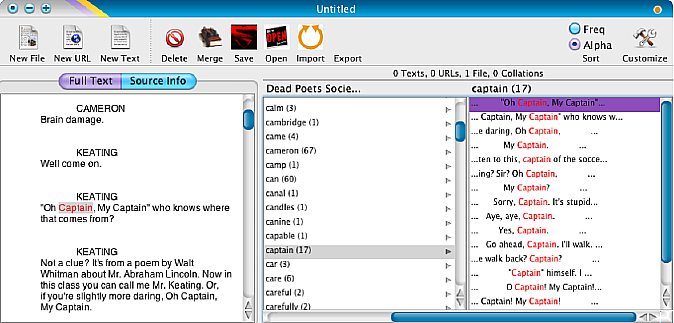
Figure 1: Full Text
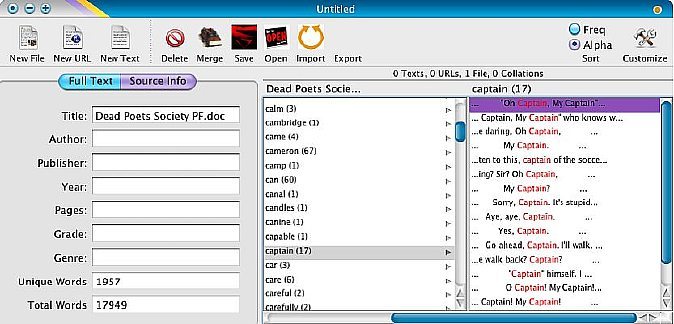
Figure 2: Source Info
Using the Preference window of Concorder Pro (Figure 3), the user can also choose how a text will be parsed and set the number of words (from one to ten) to be concorded. The basic mode offers the option of including words which contain English alphabetical letters, numbers and/or hyphens in the parsing process. The intermediate mode allows the user to list the kind of characters to be included in a word. The advanced mode is only for expert users who are able to use "formal syntactic specifications" of the UNIX programming language (see Jurafsky and Martin, 2000, p. 22).
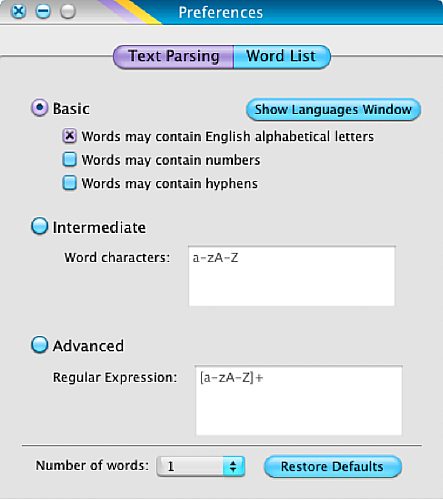
Figure 3: Text Parsing
Lyons states that, "Tokens are unique physical entities, located at a particular place in space and time. They are identified as tokens of the same type by virtue of their similarity with other unique physical entities and by virtue of their conformity to the type that they instantiate" (1977:14). Each time a text is entered into the program, a sort of occurrence list, including numerical information about the tokens of each type present in the file, is displayed automatically in the second column of the software (see Figure 1). However, it is also possible to create separate word list files. In order to create a specific word list, one can specify in the Tools menu the maximum number of words to be included in the list and whether it should be generated in alphabetical order or in order of frequency (see Figure 4). It is also possible to set exclusion and inclusion directories that allow the concorder to recall and subsequently exclude or include words from the word list. This can be done in the Preference path (Figure 5), by selecting the Word List tab. After being processed, the word list (Figure 6) can then be saved as a separate text file.

Figure 4: Create Word List
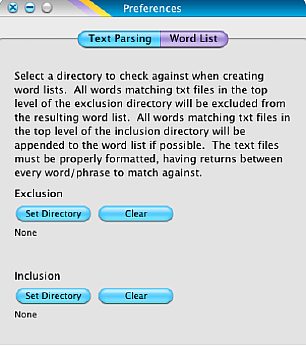
Figure 5: Word List Preferences
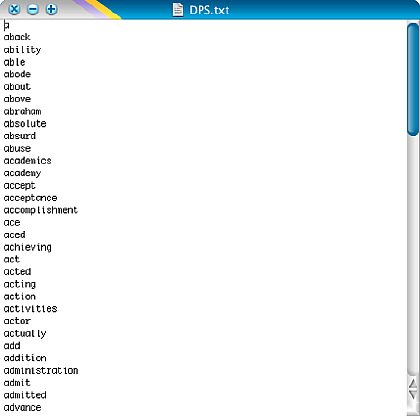
Figure 6: Word List
Provided a web connection is available, Concorder Pro also supplies the user with a dictionary that uses the online protocol of www.dict.org in order to find the required definition. When the Dictionary menu (in the Tools menu) is selected and the word entered, a definition retriever starts to look up the node in the following online databases: Elements database 20001107; Webster's revised unabridged dictionary (1913); Wordnet 2.0; U.S. gazetteer (1990); Jargon file (4.3.0, 30 April 2001); The Free on-line dictionary of computing (27 September 2003); Easton's Bible dictionary (1897); Hitchcock's Bible names dictionary (late 1800's); The Devil's dictionary (Copyright 1911, released 15 April 1993); CIA world factbook (2002); and the Virtual entity of relevant acronyms (Version 1.9, June 2002). Once the word has been found, it is then displayed in the Definition Retriever window together with all the entries related to it (see Figure 7).
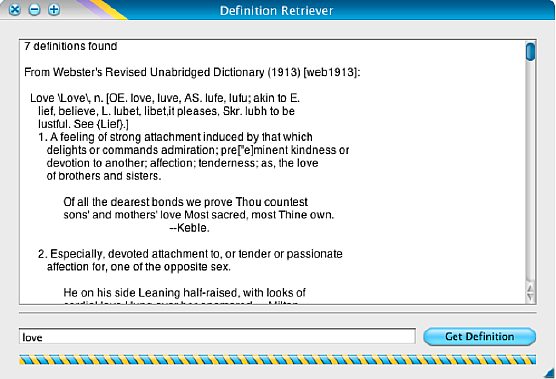
Figure 7: Definition Retriever
Concorder Pro is strongly recommended for Mac OS X users who are concerned with language study, description, teaching, and/or learning and can take advantage of information on collocations, descriptive statistics on words lists and frequencies, and the online ready-to-use dictionary that the concordancer provides.
After searching the Internet for information, it seems that, although the most common tools for the old Mac Classic System (Mac OS 9) can be made to work on Mac OS X as well, there seems to be no other text-analysis software made exclusively for Mac OS X. Consequently, Concorder Pro does not require running the Classic Mac OS 9 environment as a separate application within OS X. This is certainly a great advantage in that it saves time and troubleshooting by allowing users to work directly within OS X. This is an advantage because applications run in the Classic environment cannot take advantage of the new Mac OS X features. Thus, for instance, if an application running in the Classic environment happens to crash, it may cause (due to the lack of the protected memory feature of OS X) all other Classic applications, including the Classic environment itself, to crash. Since the Classic environment lacks the protected memory feature of OS X, unsaved data may be lost.
Researchers, teachers and learners can take advantage of the software in many ways. First of all, Concorder Pro may function as a tool for retrieving linguistic information both from texts and corpora. Collocations and concordances from texts can be used either to study or to introduce students to the main features of a text, of an author, of a genre, of a language, and so on. Concordances from corpora are relevant to language learning (and eventually teaching) for they offer the items that are likely to be encountered in natural language. This is, of course, one of the main advantages of concordancers: They offer the possibility to expose learners, teachers, and researchers to a large number of collocations in authentic contexts. Concorder Pro can also be used to introduce computational text-analysis and corpus-based approaches to students, who could later develop their own research, too. The program could also be used to prepare tests such as gap filling and collocation matching in order to assess students' language knowledge or to teach them new lexical items either by simply providing them with the examples and sample sentences that have emerged from the corpus data, or by introducing grammar rules by letting learners discover them through their own searching and analyses of the data. In other words, Concorder Pro can function either as a reference tool for the teacher (or the researcher), or as a resource-tool to be used by the teacher and/or in the class.
In addition, the Word lists and the online dictionary features are also useful for reference purposes (cf. Kennedy, 1998), for they may provide quick and ready-to-use information about the tokens or types of words in a text or a corpus.
The quick-and-ready-to-use way of retrieving material together with the ease of accessing data are two other great advantages of Concorder Pro. Users can retrieve information in a quick and very simple way without having to read full texts in order to annotate all the instances of a node word and its contexts manually. Non-expert users can easily benefit from Concorder Pro too, thanks to the user-friendly interface of the software. In addition, although the way the software works is extremely intuitive, the newbie is also provided with detailed instructions in the Help menu.
Last but not least, Concorder Pro is free software. Anyone who has an internet connection can easily download it for free and get updated versions online.
Although Concorder Pro has many positive features, it has one main weakness, in that it is a beta version. In other words, it is not-quite-ready-to-be-released software. This can clearly be experienced when trying to save files: As a matter of fact, it seems that Concorder Pro is not able to save them (except for word lists). However, this bug can be bypassed by using the Export option since exporting files also saves them as well. Another negative feature is that word lists do not include the number of tokens. Even though the second column of the software windows displays them, it would certainly be more useful to have the option to include or exclude token-numbers in separate word list files.
However, aside from these concerns, Concorder Pro can be considered THE concordance tool for the new Macintosh Operating System (Mac OS X).
Jurafsky, D. and and Martin, J. (2000). Speech and Language Processing. New Jersey: Pearson Higher Education.
Kennedy, G. (1998). An Introduction to Corpus Linguistics. London: Longman.
Lawler, J. and Dry, H. (Eds) (1998). Using Computers in Linguistics: A Practical Guide. London, New York: Routledge.
Lyons, J. (1977). Semantics: 1. Cambridge, London, New York, Melbourne: Cambridge University Press.
Partington, A. (1998) Patterns and Meaning: Using Corpora for English Language Research and Teaching. Amsterdam, Philadelphia: John Benjamins Publishing Company.
Stubbs, M. (2001). Words and Phrases. Oxford: Blackwell Publishers.
Thomas, J. & Short, M. (Eds.). (1996). Using Corpora for Language Research. London: Longman.
Wichmann, A., Fligelstone, S., McEnery, T., & Knowles, G. (Eds.). (1997). Teaching and Language Corpora. London, New York: Longman.
Pierfranca Forchini has a BA and MA in Theoretical and Applied Linguistics from the University of Pavia (Italy) and a BA and MA in Foreign Languages and Literatures from the University of Bergamo (Italy). She has taught English in primary and secondary schools and is currently working as a teaching assistant in the English Department of the University of Pavia.
|
© Copyright rests with authors. Please cite TESL-EJ appropriately.
Editor's Note: The HTML version contains no page numbers. Please use the PDF version of this article for citations. |